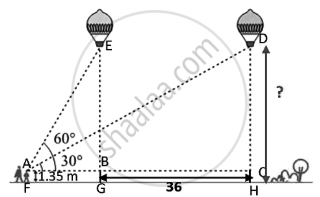Advertisements
Advertisements
Question
A boy whose eye level is 1.35 m from the ground, spots a balloon moving with the wind in a horizontal line at some height from the ground. The angle of elevation of the balloon from the eyes of the boy at an instant is 60°. After 12 seconds, the angle of elevation reduces to 30°. If the speed of the wind is 3m/s then find the height of the balloon from the ground. `("Use" sqrt3= 1.73)`
Solution

Given that a 1.35 m tall boy sees a balloon.
So, AF = 1.35 m
Also, AF, BG, and CH are parallel.
BG = CH = AF = 1.35 m
Also, given that after 12 seconds, the angle of elevation reduces to 30°. If the speed of the wind is 3 m/s, then find the height of the balloon from the ground.
Therefore,
BC = Distance travelled by balloon due to 3m/s wind in 12 sec
= Speed × Time
= 3 × 12
= 36 m
∴ BC = 36 m
And we need to find the height of the balloon from the ground.
i.e., we need to find DH
Also, the boy sees the balloon first at 60°.
So, ∠EAB = 60°
After travelling, the angle of elevation becomes 30°
So, ∠DAC = 30°
And EG = DH because the height of the balloon from the ground remains the same
Here,
∠ABE = 90° and ∠ACD = 90°
In right angle triangle EBA
tan A = `"Side opposite to angle A"/"Side adjacent to angle A"`
tan A = `(BE)/(AB)`
tan 60° = `(BE)/(AB)`
`sqrt3` = `(BE)/(AB)`
AB = `(BE)/sqrt3`
In an right angle triangle, DAC
tan A = `"Side opposite to angle A"/"Side adjacent to angle A"`
tan A = `(CD)/(AC)`
tan 30° = `(CD)/(AC)`
`1/sqrt3` = `(CD)/(AC)`
AC = `CDsqrt3`
Since BE = CD
∴ AB = `(CD)/sqrt3 "and" AC = CD sqrt3`
Now,
BC = AC − AB
36 = `CDsqrt3 - (CD)/sqrt3`
36 = `CD (sqrt3 - 1/sqrt3)`
36 = `CD ((sqrt3 xx sqrt3 - 1)/sqrt3)`
36 = `CD ((3 - 1)/sqrt3)`
36 = `CD (2/sqrt3)`
`36 xx sqrt3/2` = CD
`18sqrt3` = CD
CD = `18sqrt3`
CD = 18 × 1.73
CD = 31.14 m
Now,
Height of balloon = DH
= CD + CH
= 31.14 + 1.35
= 32.49 m
